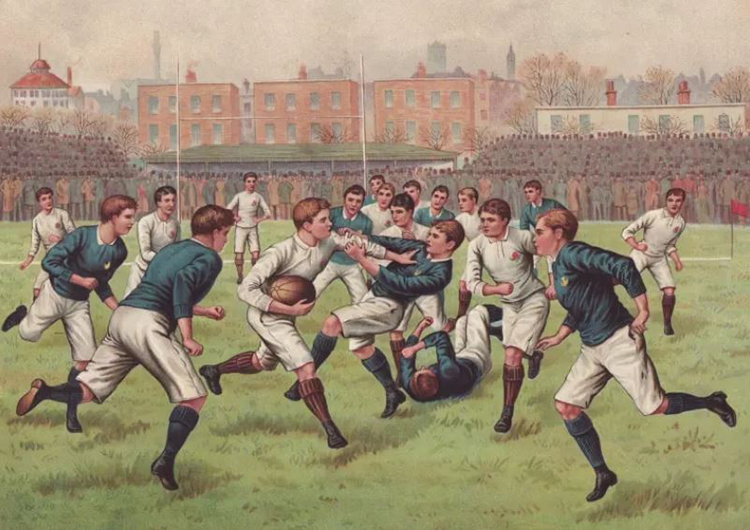Famous throughout the world, rugby is a much older sport than one might imagine.
Its notoriety in modern times is due to the presence of some international tournaments and, above all, to its inclusion among the Olympic disciplines in 2016. Since then, interest in this sport has grown steadily. But what are its origins?
Like many other sports, rugby is a discipline with roots attributable to the Greco-Roman period. There are documented testimonies of a ball game practiced in ancient Greece and very similar to the one we know today.
It took the name of episkyros and provided for the clash of two teams of players who arranged themselves in two fields delimited by lines drawn on the ground.

Also reminiscent of rugby is the ancient game of aporraxis, also of Greek origin. Despite the previous one, however, it seems to be more directly related to basketball, because the players had to hit the ball on the floor and bounce it against the wall.
Another game closely connected to modern rugby, and according to some the true ancestor of what is played today, is harpastum, developed in the city of Sparta and which found great diffusion in the Roman environment. According to the written testimonies that have come down to us, the players fought for the ball in real scrums.
The aim was to carry it beyond the opponents’ line, in a rectangular playing field, with two back lines and a median. Tackles, feints and passes were included.
the history of rugby
The game of soul in France and across the Channel
It is therefore clear that rugby was born in very ancient times, but it is not equally easy to understand how it actually got to the present day, given that evidence of the evolution of this sport has been lost over time.
In fact, it is rather difficult to follow its history through the centuries, due to several gaps. In particular, traces are lost until the Middle Ages when the soul game was practiced.
This was a widespread discipline in France around the twelfth century, especially in the regions of Normandy and Brittany, although a variant was also known beyond the English Channel, with the name of football.

The aim in the game of soul was to carry the ball over the boundary line, which could simply be drawn on the ground or correspond to a boundary wall. To do this it was possible to resort to all kinds of action with the ball and against the opponents. Reason why the game was progressively banned by the monarchs.
The ball used to underline the soul’s bond with modern rugby: in spite of the one foreseen for other games, it was a bladder covered in leather and filled with air and hay. Furthermore, the similarity of the rules to those of harpastum would suggest a Roman heritage, which explains why this discipline was also known in the lands of Great Britain.
But also because rugby is so similar to Florentine football, a sport still practiced today in some Italian areas and which would have inherited the legacy of harpastum.
The original Rules of Florentine Football
Florentine football, also known as Calcio Storico Fiorentino, is a traditional game played in Florence, Italy. Here are the basic rules of Florentine football:

- Teams: The game is played between two teams of 27 players each.
- Field: The playing field is a large sand pit with goals at either end. The field is roughly 80 meters long and 40 meters wide.
- Duration: A game of Florentine football consists of two 50-minute halves, with a break in between.
- Ball: The ball used in the game is a large, heavy ball made of leather and filled with straw.
- Objectives: The objective of the game is to score points by throwing the ball into the opposing team’s goal. Each goal is worth one point.
- Physical contact: Physical contact is allowed and even encouraged in Florentine football. Players are allowed to tackle, punch, and kick their opponents in order to gain possession of the ball.
- Fouls: There are very few fouls in Florentine football. However, hitting an opponent from behind, hitting an opponent who is already down, and attacking an opponent who is not in possession of the ball are all considered fouls.
- Referees: There are six referees who oversee the game. They are known as “judges” and they have the authority to penalize players for fouls or unsportsmanlike conduct.
- Attire: Players wear traditional costumes consisting of a shirt, shorts, and socks in their team’s colors. They also wear a cap and a scarf to identify their team.
- Scoring: The team with the most points at the end of the game wins. In the event of a tie, the game is decided by a penalty shootout.
The birth of modern rugby in 1823
Even if the evidence of a presence in Europe is ancient, the real birth of modern rugby dates back to 1823, in the homonymous city in the county of Warwickshire. It is here that William Webb Ellis during a football match took hold of the ball and started running, until he reached the end of the field.

This story, although still beaten, is testified by a plaque affixed at the Rugby School of the city, and has led to attributing the paternity of the sport to Ellis, although he has not officially claimed it.
the history of rugby 1823
The question has never been clarified and is still shrouded in an aura of mystery today. In any case, Ellis’ name is an integral part of sporting history, so much so that the World Cup is dedicated to him.
As for the rules of modern rugby, they only arrived towards the end of the 1800s, when the discipline actually took the form we know today. Clearly distinguishing itself from football, in which it was common to hold the ball in hand. Until then, therefore, the two sports were very similar, due to the lack of specific rules.
The watershed date is January 26, 1871, when the Rugby Football Union was formed in London. It is to this that we owe the creation of standard rules for all rugby players.
The main ones established the use of an oval ball (i.e. with a shape that made it difficult to kick it) and the possibility of running while holding the ball in hand. Instead, kicking the shins was prohibited.
Another fundamental rule introduced in that period was the limit of players, which was initially set at 20, then reduced to 15 around 1875.
The diffusion of sport in Europe and in the world
The success of the sport was almost immediate. Within a few years it spread to all the territories of the then British Empire and in 1886 the International Rugby Board was founded, a body that still today has decisive tasks in the management of the discipline. Although in 2014 it changed its name to World Rugby.

Traditionally England is the nation most closely linked to the history and development of rugby. So much so that even today it boasts the highest number of players in the world and its national team is among the best in the world, as demonstrated by the numerous successes in the various editions of the World Cup.
The first nation to follow the English example was Ireland, where the worldwide diffusion of sport began. In 1854 rugby arrived at Trinity College, Dublin, to great appreciation by the students. The schools were also a decisive landing point in Scotland, where the first rugby club was founded in 1858.
Gradually the discipline landed in all European countries, with a rapid diffusion in France, which became part of the annual tournament of the four British nations in 1910, transforming it into the challenge of the Five Nations. Italy only joined in 2000, when the competition acquired the name of Six Nations.
Worldwide, one of the areas where rugby has had a strong diffusion since the mid-1800s is Oceania. Suffice it to say that at the beginning of the twentieth century, there were already more than 100 clubs in Australia.
New Zealand, on the other hand, has made it a national sport. A union that seems indissoluble, because not only is the game of the oval ball very popular with the New Zealand public, but their national team, the All Blacks, is considered the strongest in the world and the one with the most pictoresque anthem: the Haka.
The Haka
The haka is a traditional Maori war dance of the Indigenous people of New Zealand. It is a powerful and iconic cultural performance that is often associated with the All Blacks, New Zealand’s national rugby team.
The meaning of the haka can vary depending on the occasion, but it is generally a way to express pride, strength, and unity. Historically, the haka was performed by Maori warriors before going into battle to intimidate their enemies and demonstrate their readiness to fight.
Today, the haka is performed for a variety of reasons, including to celebrate special occasions, to honor someone’s achievements, or to welcome guests to a community
In Africa rugby finds its nation of choice in South Africa. But territories such as Fiji, Western Samoa and Tonga have also shown a strong link with this sport, immediately recognizing it as a national discipline.





